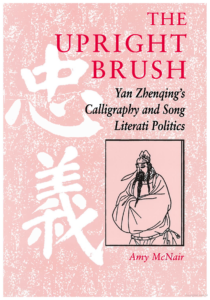HONOLULU: UNIVERSITY OF HAWAII PRESS, 1998
XVII + 177 PAGES
Amy McNair has written a splendid study of a major Tang dynasty (618–906) political figure, Yan Zhenqing (709–785), and the manner in which his reputation as a statesman and calligrapher grew during the subsequent Song dynasty (960–1279). McNair’s text is part biography, part historical overview, part artistic analysis—with the pieces coming together in a deeply satisfying picture of Yan Zhenqing as a Tang loyalist whose bold brushstrokes were appropriated by eleventh-century literati as perhaps the most fundamental example of “square,” or “upright” calligraphic style.
I have used McNair’s examples in several of my classes, even though the complete study is too specialized to assign to many of my classes. (I will be using the entire text in a Tang-Song China class next spring, however, where I believe it will be a very good fit.) My students immediately respond to my first inquiries about Chinese writing with the position that calligraphy is “creative,” and “artistic,” representing the personality of a writer. One of the most useful teaching opportunities that this book provides is to deeply contextualize attitudes toward writing and calligraphic style that go against many students’ ingrained ideas of spontaneity and originality in the creation of artworks—to understand that even such words as these have multifaceted cultural and historical dimensions.
McNair focuses on the connection between Yan Zhenqing’s work as a highly placed scholar-official during a particularly tumultuous period of Tang history and the actual texts—in form and substance—he created during his lifetime. Yan Zhenqing served as a Tang official during the divisive eighth-century An Lushan rebellion (755–763) and its highly charged aftermath, which was marked by bitter factional disputes at court. Yan is known widely to those familiar with traditional Chinese historiography for his dedication and unbending loyalty to the Tang state. Suffering through the deaths of friends and family members, Yan survived rebellions, uprisings, and a series of provincial appointments, only to be executed at the hands of rebels in his eightieth year.
McNair connects this well-known biography—which she deepens through her focus on his artistic models—to the aesthetic reception of Yan’s calligraphy three centuries later. Her core question strikes students unacquainted with Chinese art as strange—how did a calligraphic style that, even among admirers, elicited such reactions as “clumsy,” “simple,” and “bland” come to dominate the imagination of a group of later reform-minded literati who, in turn, would help shape the views of countless scholars in the later imperial age?
 The first thing McNair notes is that these terms are hardly negative in the context of Tang-Song calligraphy. She takes the reader through a fine discussion of “characterology”—the long-held Chinese idea that calligraphy expresses the personality and moral character of the writer. What brings her work to a new level of significance, however, is her specific connection of these general ideas to a core group of reformers in the mid-eleventh century who reshaped the way in which Yan’s calligraphy was viewed. Ouyang Xiu (1007–1072) and many of his contemporaries aggressively posited Yan’s style as “upright,” “open,” and “forthright,” as opposed to the “seductive beauty” and “slanting style” of Wang Xizhi (303–361), the imperial model for several centuries.
The first thing McNair notes is that these terms are hardly negative in the context of Tang-Song calligraphy. She takes the reader through a fine discussion of “characterology”—the long-held Chinese idea that calligraphy expresses the personality and moral character of the writer. What brings her work to a new level of significance, however, is her specific connection of these general ideas to a core group of reformers in the mid-eleventh century who reshaped the way in which Yan’s calligraphy was viewed. Ouyang Xiu (1007–1072) and many of his contemporaries aggressively posited Yan’s style as “upright,” “open,” and “forthright,” as opposed to the “seductive beauty” and “slanting style” of Wang Xizhi (303–361), the imperial model for several centuries.
Indeed, McNair examines a number of pieces that might well be considered drafts or sketches in another context. In particular, her analysis of the “Draft Eulogy for Nephew Jiming,” written just after his nephew’s execution by rebels in 756, shows an example of a forthright and earnest style—with several crossed-out characters, attributed to the emotions of the writer—that was praised by eleventh-century literati as reflecting a sincerity that was all too often lost in more refined styles. Introductory and intermediate students are invariably surprised to learn that, as much as the work’s powerful rhetoric, it was the actual brush strokes that had a lasting impact on later generations. The opportunity, through McNair’s carefully analyzed examples, to teach students about the appeal of calligraphic models beyond the pure aesthetics and beauty of brushstrokes (a complex enough challenge in its own right) is a wonderful one, and can add deeper dimensions to Chinese Studies classes at virtually any level.
Beyond the use of such examples, which give teachers the opportunity to draw widely from McNair’s skillfully argued text, the work has limited uses below the advanced undergraduate level. However, this magnificent study should be recommended enthusiastically to teachers and scholars, for its analyses carry it well beyond the confines of Tang-Song specialists or art historians. It is a work that will make all readers more deeply sensitive to the nuances, stylistic concerns, and artistic reception found in the Chinese calligraphic tradition. For teachers of Chinese history and culture, that can only result in a deeper sense of calligraphy’s aesthetic and political importance than most of us have in our repertoire.

